#saltlakefilmsociety
Photo

A glimpse into the Birthday Palooza Fun we had today. The Food, Conversations and Connections of today have been Amazing! Thank You All for the posts, messages, emails, videos and more! My cup runneth over and the Palooza isn’t even over yet! #birthdaypalooza #daughterandmother #strawberryangelfoodcake #rubysnapcookies #downtownslc #broadwaytheaterslc #saltlakefilmsociety #yetimicrophone #blueyeti #happywifehappylife #feedingmyaliveness #mycuprunnethover https://www.instagram.com/p/Bvx1-hXAWGF/?utm_source=ig_tumblr_share&igshid=uwnhewmotcm4
#birthdaypalooza#daughterandmother#strawberryangelfoodcake#rubysnapcookies#downtownslc#broadwaytheaterslc#saltlakefilmsociety#yetimicrophone#blueyeti#happywifehappylife#feedingmyaliveness#mycuprunnethover
0 notes
Photo

Haha! @saltlakefilmsoc, you make me smile! #starwars #trashcompactor #anewhope #madmax #madmaxfuryroad #sciencefiction #scifi #towertheatre #slc #saltlakecity #madmaxfuryroadblackandchrome #saltlakefilmsociety #movie #film (at Tower Theatre)
#saltlakecity#trashcompactor#saltlakefilmsociety#madmaxfuryroadblackandchrome#movie#towertheatre#sciencefiction#anewhope#slc#scifi#film#starwars#madmax#madmaxfuryroad
0 notes
Photo
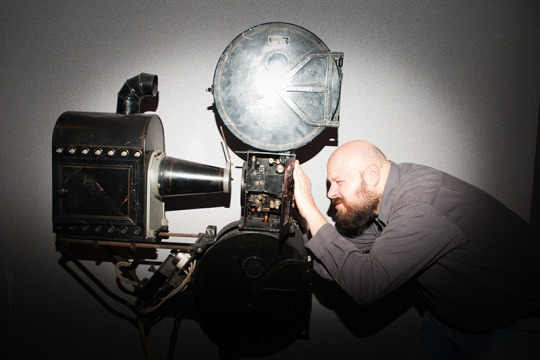
The Dying Art of Light
This article was first published in the January 2014 issue of SLUG Magazine. Read it online or in print on page 33.
Over 100 years after Cinématographe was invented and used by the Lumiére brothers in France to show the first paying audience a projected film, Edward Norton looks directly into the camera as he explains the job of a projectionist in a scene from Fight Club. “Why would anyone want this shit job?” he asks as his alter-ego Tyler Durden splices pornography into family cartoons. “Because it affords them other interesting opportunities.”
Walking up the steps to the projection booths of the Salt Lake Film Society’s Broadway Theatre, I imagine what it would’ve been like, watching that scene from Fight Club when it showed in theaters in 1999, from a projection booth—like looking at a reflection, perhaps.
Lance Walker, SLFS Head Projectionist, has been working in the booth since 2001, just before the Salt Lake Film Society came into fruition to save the Tower Theatre from demise. “There really wasn’t anyone else who could come here and do it, so they trained me and the other guy who was working the concession stand at the time … They showed me really fast how to do it, and everything else I’ve had to learn on my own,” he says. Walker speaks slowly and affirmatively—he reminds me of a more subdued version of Wallace Shawn’s character in The Princess Bride—a little bored, a little cynical, and his rare smile reveals an endearing gap in his teeth behind a full beard.
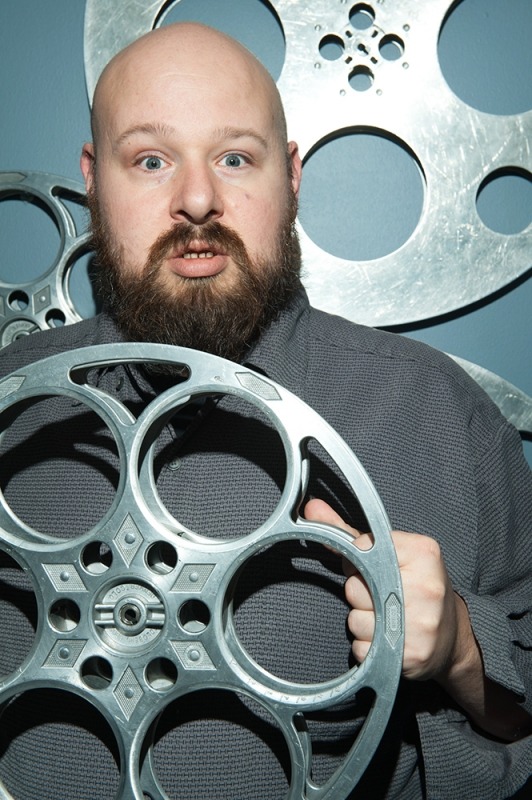
Lance Walker, Head Projectionist for the Salt Lake Film Society, has survived the digital conversion, though his job has considerably changed. Photo: Russel Daniels
We walk through the hallway to the projection booths and Walker apologizes for the smell, but the overwhelming aroma of popcorn that fills the lobby below doesn’t seem to penetrate the dark upstairs. Instead, the winding hallways contain a light scent of dust among the organized clutter of boxes, tables and machines—very few people come up here, which is part of the magic.
“I like the projection booth because it’s like a dark hole that no one really wants to go into,” says Walker. “It’s loud and dark and it’s not a place for people to go.”
Tyler Durden defines the employment opportunities of a projectionist as creative mischief, but speaking with Walker—and having worked in the movie theater business myself for nearly a decade—I realize that, though most projectionists aren’t using their position to terrorize children, there’s a certain character trait needed to draw someone to the booth: those who find solace in solitude. Walker tells me he’s not much of a film fanatic, citing The Shining as a favorite, and admitting he prefers B movies he can watch and be done with in the comfort of his own home. “ … I can pause [the movie], get food or drink, go to the bathroom and never miss any of it. I can have the lights on or off. I don’t have to come into work or any of the other movie theaters, now very demanding of you knowing exactly where you want to sit. I’m not into that,” he says. “I guess I might be a control freak.”
A few days later, Scott Farley of Brewvies Cinema Pub, and I sit in a booth at Juniors discussing his own film interests: “I think I have a fairly deep knowledge of film for a pedestrian, but not for a film buff,” he says. “I would say that I am an autodidact and there were times when it was necessary for me to know film … I sort of tried to surround myself with people who were real cinema heads and try to get them to educate me, but … I am pretty absent from my own personality, and what people tell me to think, I’m pretty easily convinced of … ”
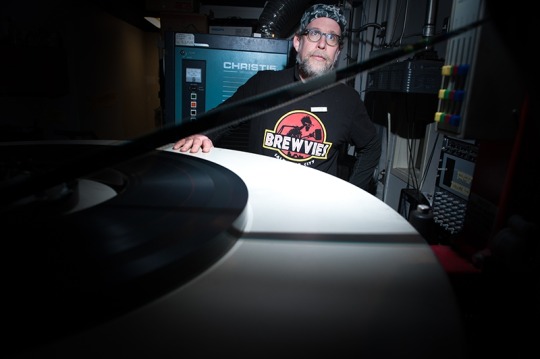
Scott Farley of Brewvies Cinema Pub boasts over three decades of experience in the projection booth. Photo: Russel Daniels
Having spent a few years’ worth of Friday nights with Farley closing up Brewvies when I worked there, I can personally attest to his above-average knowledge and understanding of film, having benefitted from a number of his recommendations—and anyone can call the Brewvies Movieline at 801-355-5500 to hear his forcibly optimistic and concise reviews for the current lineup.
Farley’s history in the booth starts in Logan, when he was attending Utah State University in 1985.
“You try to have jobs, and since you can’t make a lot of money because there isn’t a lot of money to be made unless you’re having a miserable life, you come up with jobs where your perks also fill your social needs,” he says, explaining what led him to start working at a movie theater.
“Dates were free, and I could hook up friends on any number of levels, so I had entrées of social significance greater than just my charming personality.”
Farley eventually ended up at the Tower Theatre, working under Greg Tanner before the SLFS took over, making his way to Brewvies in 1997. “I kind of left being a projectionist when I came to Brewvies,” he says, admitting that the years he’s been at the cinema pub have been more fruitful as a bartender. Though it’s true that the job is now predominantly accomplished by the bussers, they’re trained at a very surface level, making Farley’s nearly three decades of projection experience crucial when it comes to troubleshooting impending film disasters—soon to be antiquated memories.
In his 2011 documentary series, The Story of Film: An Odyssey—consequently another Farley recommendation—Irish film critic Mark Cousins describes film as “the art of light.” He says, “[Thomas] Edison and the many other manic, ideas-y inventors of cinema realized that beyond the equipment and machines, what you needed most for movies was light”—essentially making the role of the projectionist somewhat of a poetic intermediary between the art and the audience.
According to the first episode of the series, and confirmed by Walker’s extensive knowledge of traditional movie projectors, the actual machine is an amalgamation of varying components from other inventions, including the sewing machine and the vacuum, slowly tweaked by new innovations, but not as quickly evolving as one would expect compared to the technological advances surrounding it. Perhaps this is why, a year after Tyler Durden explains the basics of projector mechanics, the first digital projectors are installed and tested in a few movie theaters across the country.
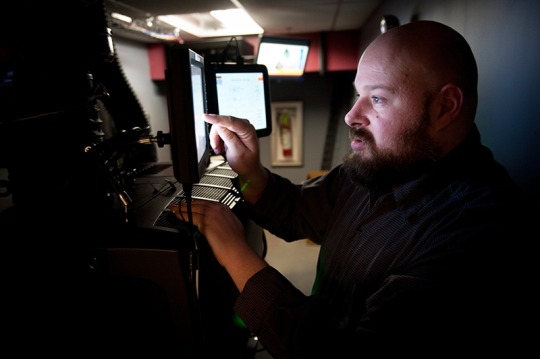
SLFS's Lance Walker enjoys the more carefree, digital format of projecting films. Photo: Russel Daniels
Nearly 14 years later, the labs producing celluloid film are shutting down and movie studios big and small have finally caught up with the digital, economical and eco-friendly age, sending notices to theaters, independent and commercial, that they’ll no longer be producing 35mm prints. Instead of heavy, metal canisters of film, briefcases are arriving on theater doorsteps full of hard drives about the size of a paperback—compressed movie files. Large chain theaters, like the Megaplex at the Gateway, completed their conversion to digital a couple of years ago, but a quick search on Google reveals that independent theaters across the country are struggling to purchase the expensive new projectors in time to meet the studio deadlines—a story of its own. Salt Lake’s independent theaters have survived the changing of the guard, and at the Broadway, aside from two running 35mm projectors, the outdated machines have been pushed into even darker corners to make room for whirring blocks—looking a bit like oversized window units—topped with glowing touch screens. In one day, Walker laments, a century’s worth of invention and innovation was replaced.
“Film” is a vestigial word now.
The job of the projectionist, though, is still very much alive, however changed. “I was led to believe that the digitals would take care of themselves, which they haven’t done yet, so I still have a job,” says Walker. “They never implied that I would be fired, but that I would have less to do. It’s all the same amount of work—it’s just different work.” Walker is now part DJ, part IT tech. His day begins by uploading or “ingesting” the movie into the digital projector, inserting special keys sent via email to decode the encrypted information, and then, essentially making a playlist that includes a schedule of showings, trailers, credits, etc. “When it was all 35mm, you would come in and turn on the power, thread up the movies, and you were ready to go,” says Walker. “Now, you have to make sure the machines are actually networked, and sometimes you have to restart them several times to make sure that they’re connecting. So it just takes a lot more time to get the day started, but other than that, you just put in the schedule and it goes. Then someone complains about it—the cleaning lights have been left on—and you’re like, ‘That’s not my deal—the machine left the cleaning lights on.’ When automation is going, it just makes people think it’s taken care of—‘I don’t have to worry about it.’ Digital is a fickle thing.”
At Brewvies, the two back-to-back 35mm projectors have not been converted as of writing this article, though they’ll be switched out soon, but Farley sees the change as a positive one. “The idea of not having to use resources which are largely slandered, and ship items across the country that burn carbon—it’s going to be a great efficiency and a great good in a deep ecological sense to not have film,” he says. “The projection will always be significantly improved, because it’s really easy to flub a film and ruin it, and digital looks good now.” Walker agrees, saying, “I really think that whoever did the digitals went around and figured out all of the awful things that happen, and they did a really good job in putting their thing together.”
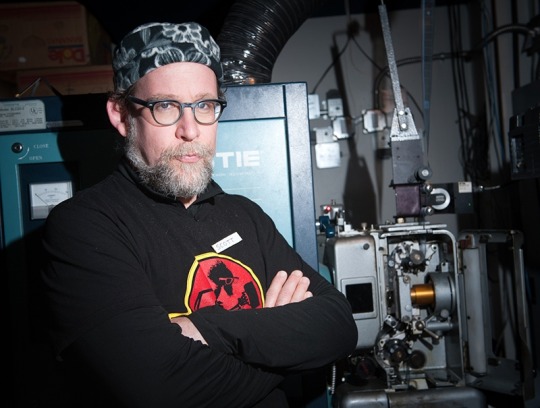
Brewvies' Scott Farley acknowledges that going digital will make film projection a bit more environmentally friendly. Photo: Russel Daniels
There’s no romanticizing 35mm film when you’re the one spending a whole night in the booth, putting together two miles of film after dropping a print—which Farley admits to having suffered on a couple of occasions in his early days as a projectionist. “That will never happen anymore—I will never have to look at a projector and think, ‘How do I fix this?” he says, pausing with what I read as a hint of poignance.
For myself, threading the film through the projector was a meditative respite from the rush of working as a barback. It was detail-oriented, mechanical work that satiated a compulsive urge. It was a small piece of art that I mitigated to an audience through a machine whose parts contain the genealogy of industrious and romantic ideas. The digital conversion has changed the mechanics of cinema, evolved the projectionist from a torchbearer waiting in the shadows to a button pusher glowing in the dark, but no one’s really crying about it. “It is, after all, just an aesthetic end you’re searching for,” says Farley. “There’s no quantity of truth you’re trying to get out of it because it’s a lie anyway—you’re just trying to get a really great lie.”
#words#slugmagazine#filmmaking#projection#film#saltlakecity#saltlakefilmsociety#brewvies#storyoffilm
0 notes
Video
instagram
My gore-geous boy @saint_luxe catching me off guard after “Kill Baby…Kill!” on Friday. I won a pumpkin because I know too much about giallo. #thegothicalice #halloween #horrornerd #slfs #saltlakefilmsociety #towertheater
99 notes
·
View notes
Note
saltlakefilmsociety. org/now-playing/broadway bea should i go see any of these movies
i havent heard of any of these so go see them all imo
2 notes
·
View notes
Photo

Aaaannd that made a good afternoon. Fellow nerds, recognize my pendant? #madmax #madmaxfuryroad #sciencefiction #scifi #towertheatre #slc #saltlakecity #madmaxfuryroadblackandchrome #movie #film #saltlakefilmsociety
#madmaxfuryroad#slc#madmax#towertheatre#sciencefiction#saltlakefilmsociety#saltlakecity#madmaxfuryroadblackandchrome#scifi#movie#film
0 notes
Photo

Today we set out to enjoy a day of clear air in SLC. We enjoyed delicious food, saw a good documentary (The World Before Your Feet) and then literally crossed paths on the street with the kid’s boss, Dr Pam. Thanks for that nudge Birthday Boy! I think Cheri falls in love with Utah more with each new First she experiences. #utah #saltlakefilmsociety #pizzanonoslc #rubysnapcookies #theworldbeforeyourfeet #9thand9th #birthdayinheaven #anotherfirstinutah #feedingmyaliveness https://www.instagram.com/p/BrWViuTgF_U/?utm_source=ig_tumblr_share&igshid=1fmk5vcq46qyl
#utah#saltlakefilmsociety#pizzanonoslc#rubysnapcookies#theworldbeforeyourfeet#9thand9th#birthdayinheaven#anotherfirstinutah#feedingmyaliveness
0 notes